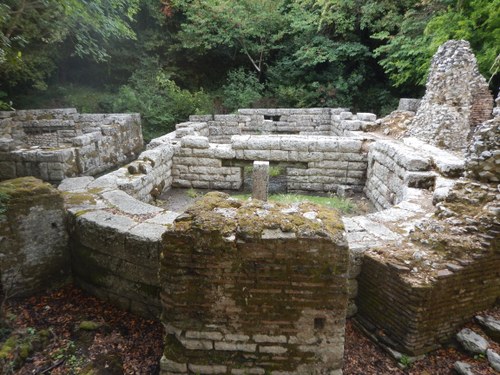Tower Gate

The Tower Gate probably represented the formal entrance to the city and to the Sanctuary of Asclepius between the 4th and 3rd century BC. It is the most prominent among the gateways found in the city, facing the crossing point of the Vivari Channel and the route through the Pavla Valley, on the opposite end of the south fortification wall to the Asclepieion Gate. It was excavated for the first time by P. Marconi.
The gateway was characterised by two towers, one squared and the other U-shaped, and monumental twin portals made of rectangular blocks with rusticated surfaces. Each tower has an arrow slit facing into the passage between the gates. The gate between the towers was equipped with sliding catharactae used for closing from above. The second gate was set further toward the rear of the passageway. G. Pani discovered also another entrance, adjacent to the square tower on its west side.
The U-shaped tower is divided into two smaller rooms that communicate through a central door. In the middle of each space there is stone column that supported the floor beams of the upper floor. The walls of the towers are 1 m wide. For what concern the U-shaped tower, its walls were constructed with rectangular blocks in courses of unequal height, with a tendency towards pseudo-isodomic style. The outer faces of the stones have been roughly worked with a hammer, which makes them similar to the north side of the Lion Gate passage.
Both Marconi and F. Winter, who studied the gate after him, dated the complex to the 3rd century BC, on the basis of the portcullis used in order to eliminate attackers. Nevertheless, Winter could found only two of them dated to the Hellenistic period, while the others were all built during the Roman age. Pani dated the Tower Gate to the beginning of the 3rd century BC, because he noticed how the gate was not tied into the wall to the northeast, while Ceka to the end of the 3rd century BC, after the Illyrian captured Phoinike in 230 BC.
Bibliography on the subject
-
Giorgi E. e Lepore G., “Comparing Phoinike and Butrint. Some remarks on the walls of two cities in Northern Epirus” in Caliò L. M., Gerogiannis G. M., Kopsacheili M., Fortificazioni e società nel Mediterraneo occidentale, Albania e Grecia settentrionale, Roma, 2020, pp. 153-181
-
Hansen I. L., Butrinti helenistik dhe romak. Hellenistic and Roman Butrint, London - Tirana, 2009
-
Karaiskaj G., Crowson A. (edt), The fortifications of Butrint, English edition of Butrinti dhe fortifikimet e tij (Tirana 1986), London-Tirana, Butrint Foundation, 2009, pp. 43-45
-
Kosta L., "Rezultatet e gërmimeve arkeologjike në Butrint në vitet 1975-76 / Fouilles archéologiques 1975-1976 dans la cité de Butrint" in Iliria, vol. 11, n°1, 1981, pp. 93-154
-
Mustilli D., "Relazione preliminare sugli scavi archeologici in Albania (1937-1940)", in Reale Accademia d'Italia. Rendiconti della classe di scienze morali e storiche, f. 12, series VII, vol. II, Roma, 1941, pp. 677-704
-
Pani G., "Restauration de la Port a Tours de Butrint" in Monumentet, vol. 11, 1976, pp. 35-44